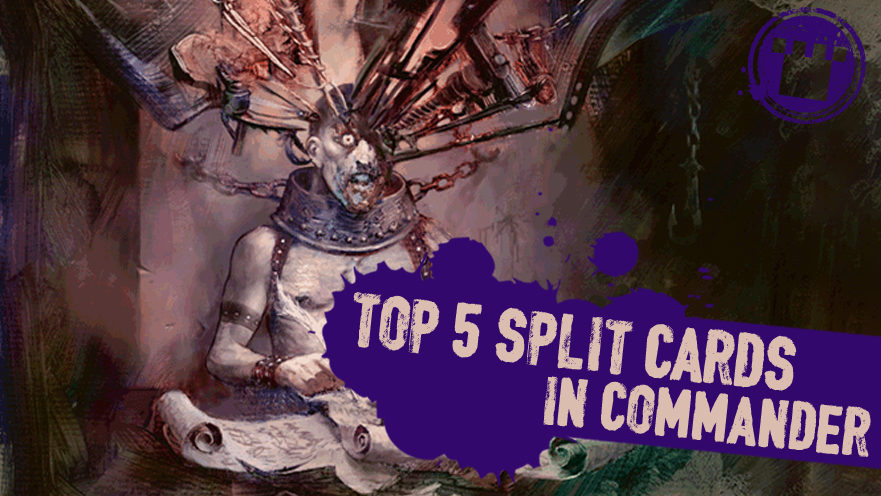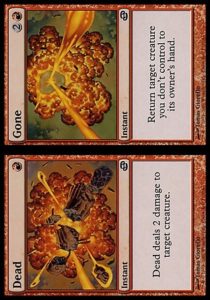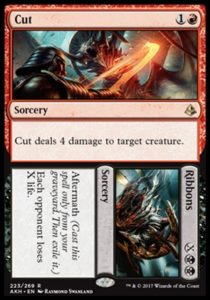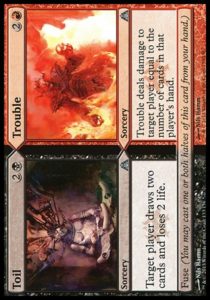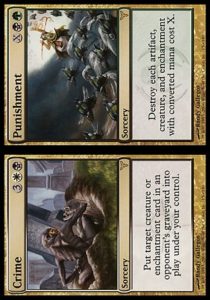MORE GONE THAN DEAD
I’m not a competitive player, but I am a huge fan of scrolling through tournament decklists to find cards for Commander decks. Back when I first started playing Magic, it was a good way to stay engaged in Magic, learn cards I didn’t know, and focus on the format I cared about.
I was wandering aimlessly through Modern Red Deck Wins lists one night and stumbled on Dead-Gone. Dead is a good option for the often-overused Birds of Paradise, or pesky Commanders like Gaddock Teeg, but Gone is actually the better half. With so many ways to establish strong sources of advantage, tempo is an overlooked quality in Commander. Particularly in Mono-Red, card advantage is still shallow relative to other available card pools, but this is where Red can really shine. With so many powerful creatures like Eldrazi, and so many haste enablers, a red deck wants to force an opponent to over-commit their mana on a game-ending threat. This is because being ahead means you’re the aggressor, tapping out and putting pressure, and therefore leaving yourself extremely vulnerable. Gone is the kind of insurance that can protect you from losing, and really pull the rug out from underneath a Kozilek or Ulamog. You might even feel especially cool if your opponent cheated it into play, and now they have to wait multiple turns before it can come back down.
SENDING CREATURES TO DISTANT PLACES
People often forget that Magic isn’t just made for the big-money formats. Whether it was totally intended a just a happy accident, Far-Away is one of the niftiest removal spells this side of our second trip to Ravnica.
Although Far-Away may seem like just a couple removal spells stapled together, its applications in multiplayer Magic make it special. In Commander, one of the biggest balancing acts is learning how and when to use spot removal. Leveraging their value relative to timing is tricky; most archetypes don’t want to fire off spells early of aggressively, but they also don’t want to hold up removal and not use it.
Far-Away‘s ability to remove two creatures makes it one of the best cards for mentally transitioning from single-player to multiplayer. Stuck somewhere between Barter in Blood and Return to Dust, it’s in a weird class of cards that can adequately disrupt your opponents without drastically affecting the board state. It handles single threats very well, whether they’re coming from one player or several. You’re almost always going to fuse this, but the lines of play are always fun to navigate.
HOORAY! GIFTWRAPPING!
I’ve never been good at wrapping presents, but I recognize good work when I see it. Cut-Ribbons is not a card I’ve played yet, but I dig it, my friends dig it, and if it plays half as well as I’m about to speculate, then it is going to be a solid Commander goodie.
We have two cards that are halves of cards —Mizzium Mortars and Exsanguinate— that most Commander players should recognize. I say “halves” because neither is a direct reprint: Cut doesn’t have Overload, and while Ribbons can take life away, it doesn’t give you what you took. At first glance, Cut-Ribbons seemed like less than the sum of its parts, but I’ve come around on this card. Cut-Ribbons is solid, and if either piece were more powerful, the full card would be busted.
We’ve danced around the dynamics of split cards with Fuse, and the choices we make casting one half or the other, but there’s something really nice about the order of operations for Aftermath cards. Whether we’re playing Control or Aggro, both halves of Cut-Ribbons are going to be useful. Control players will want to cast Cut to mow down creatures and protect their life totals, while Aggro decks can mow down blockers and make way for more damage. Ribbons also plays multiple roles – Control decks can cast Ribbons for lethal at the end of a long game, while Aggro decks can use it as a Plan B during board stalls.
I don’t want to put a bow on it just yet, but I see this card as having a lot of potential for Black-Red decks moving forward.
ALWAYS TOIL WITH TROUBLE
For the sake of fun and gaming, I’ve replaced most of my tutors with card draw. It’s a great compromise: I love drawing cards, and I still get the challenge and excitement that comes from having to play whatever I pull off the top.
Toil is an okay draw spell made better by its mischievous counterpart, Trouble. Toil’s color-friendly cost makes it easy for 3+ color decks to slot it in over the classic Sign in Blood or the newer Succumb to Temptation, but we play the card for the fun fuse has to offer us.
Around the mid-to-late game, Toil-Trouble‘s options turn from in-the-tank utility draw spell to punishing burn spell for those keeping their cards too close to their chests. When the cards are fused, what was once an obvious choice of targeting yourself with Toil becomes a more interesting debate with Trouble, as Toil adds four extra points of damage to the player you target with Trouble. It can be difficult to justify giving anyone extra cards, but if they have six in hand, dealing ten damage for 4RB and a few extra cards still feels like good value.
DOES THE CRIME FIT THE PUNISHMENT?
The Dissension split cards are some of my favorites. Each one contains great design compromise in terms of power, combining the functionality and strangeness I look for when I think about my favorite Magic cards. The best of these, in my opinion, is Crime-Punishment. It’s more straightforward than Pure-Simple, and not as cheeky as Hide-Seek, but both sides are strong meat-and-potatoes spells that shape compelling gameplay.
Punishment is a great board wipe that’s only improved over time. Planeswalker cards and abundant indestructible permanents help its case, but the truth is, it was always good. Much like Pernicious Deed, the OG of scalable destruction, cards like Punishment are still few and far between for good reason: they are powerful, and they can protect the cards you want to keep around. Before the influx of Abzan cards, this was the best way to control with Karador or fill graveyards for Teneb, the Harvester.
Crime gets less use than Punishment, but that doesn’t mean it isn’t exciting. I particularly enjoy using my opponent’s cards to further my game plan, and the interactions with this card can be fairly unique. Crime is the only card in Magic that can reanimate your opponent’s enchantments, which was irrelevant to me until the day a Lurking Predators, a Phyrexian Arena, and a Sun Titan walked into a bar ended up in the graveyard, and I had to make a fun choice about what to do next. I guess what I’m saying is, sometimes Crime pays.

For most of his Magic-playing life, Aaron has been playing and writing about Commander. One of the few mono-colored players in a gold-bordered world, Aaron enjoys the challenges of creating meaningful, memorable games, as well as the excitement that comes with engaging underrated cards as he explores the format’s uncharted territory. A disciplined deckbuilder with over 200 lists to his name, Aaron has spent the past several years creating content about his favorite format.

